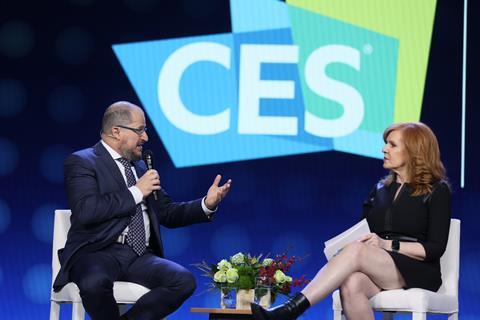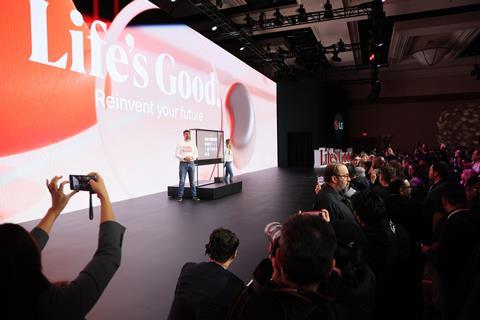The established bellwether of the tech industry, CES2024 has delivered in its usual frenetic style. Mark Mayne rounds up some of the good, the bad, and the downright left-field…
As widely discussed in advance, CES2024 was likely to deliver several different perspectives on the year to come in tech, with a clear focus on AI, VR/AR and the latest and best LED panels on the planet (as highlighted in IBC365’s CES2024 Preview feature). These elements there certainly were in considerable profusion, as well as some unexpected pleasures.
Strong LED Presence
Certainly one of those pleasures was the Transparent Micro LED TV, courtesy of Samsung:
Impressive TV tech from Samsung #CES2024pic.twitter.com/YLkser3oW4
— Dave Snelling (@SnellingD) January 8, 2024
Arguably not entirely practical without a carefully stage-managed dark background, but visually stunning nonetheless.
Paddy Taylor, Head of Broadcast, MRMC commented on CES2024 in the round: “The show was packed with LED providers, and it was very interesting to see a lot of the XR content for in-stadium experiences encouraging fans to get their phones out to get the full benefits of the content being offered. At MRMC we were talking about our automated production tools which utilise AI. This was undoubtedly a buzzword at the show, for which we generated interest with our Unreal Ride. I was also blown away by the number of EV tie-ups that were being promoted.”
Watch more Challenges for OTT service providers around the world
Another visual feast was what LG claimed was ‘The World’s First 4K wireless transparent TV’:
The LG transparent TV display at #CES2024 is definitely one of the highlights pic.twitter.com/Kv0Y73Q6KJ
— Dave Snelling (@SnellingD) January 9, 2024
Immersive AR, VR and XR Make for Key Talking Points
Although widely telegraphed in advance, Qualcomm’s CES keynote dwelt much on the promise of AR and XR as serious enterprise tools, with Qualcomm president and CEO Cristiano Amon pondering: “How do you train people? How do you fully immerse in that digital environment? How do you evolve communications?” He also highlighted Qualcomm’s development work on AI, pointing out that the chipsets to run AI applications pervasively are now beginning to reach the market, and that the next step will be developing real-world use cases.
Qualcomm’s Snapdragon XR2+ Gen 2 Platform was also announced at CES2024, offering slightly boosted performance over the previous (non-+) version. “We look forward to continuing our collaboration with Qualcomm Technologies and Samsung on the future of immersive and spatial XR,” said Shahram Izadi, vice president of AR at Google in a release. “We’re excited for the Android ecosystem to take advantage of Snapdragon XR2+ Gen 2’s capabilities and enable new experiences.”

Anton Christodoulou, Group CTO, experience design agency Imagination commented on the show, further highlighting the theme of immersive technology.
“Many people will say that AI defined CES, but while it was everywhere, it did not really move the needle and was arguably less impactful than CES2023 in terms of real-world advances. It appeared in more products, some with valuable benefits and some with dubious ones. What took centre stage this year, however, was immersive technology in its many forms.
“Many of the big brands not only embraced this to showcase their products and services; in many cases, they actually were the products and services. Sony has always been good at showcasing their technology at CES, and this year, the fruits of their early consumer VR adoption were transformed into a creator AR headset in partnership with Siemens. The so-called “Industrial Metaverse” product is designed to help creators use AR as an integral part of the design process. But Sony didn’t stop there.
“Sony’s TorchLight studio has been set up to allow filmmakers to scout real-life locations using Unreal Engine first, setting up shots and lighting before doing the final real-life film shoot on location. Their virtual production demo showed how this technique can be used to create impressive film shoots, including a moving car shot across a bridge using a short film shot to demonstrate the power of this technology firsthand. Sony Pictures’ investment in Location Based Experiences was impressively demonstrated using projection and haptics, where you interact with the Marshmallow Man while screaming down a New York street behind the Ghostbusters car. The interactive haptic floor was also a nice touch.”
AI Present, but no Big Bang Moment
Mark Harrison, CEO, DPP agreed that the promised raft of AI applications was more muted than expected: ”The big story for CES 2024 was a negative: the expected explosion in generative AI didn’t happen. But the lack of an explosion seemed to cause many to miss some gen AI highlights from the tech giants. Google’s Duet AI brings generative AI tools to Google Workspace, and is available now. If that’s not an AI wow moment I’m not sure what is - and yet it went largely unreported.
“Personally I enjoyed the application of gen AI to Google Maps - enabling you to see what a place will look like at a time and in the weather conditions several days ahead. Meanwhile Amazon showed off its partnership with Embodied to create Moxie - a learning robot for children. When a demonstrator has the confidence to invite audience participation for generative AI, you know the product is real. No wonder such interaction wasn’t possible for LLMs in cars: that conjures a trade show horror show probably best avoided.”
Smart Home Evolution Continues Apace
Jack Narcotta, Principal Analyst, Omdia picked out collaboration as a strong point of the show, specifically on the smart home side.
“Each year, thousands of people travel to CES to find - or showcase - the next big thing in consumer electronics. But initiatives that highlight the technology industry’s evolution can also be found at the high-profile event in Las Vegas.

“At the 2024 trade show, there was an important update on Matter, a protocol for smart home devices that had been released by the Connectivity Standards Alliance (CSA) just over a year earlier. Matter was established with an ambitious goal – to alleviate the frustration people feel when they’re trying to connect products such as smart light bulbs, locks, cameras, and air conditioners to their home network and to similar devices. It sets out to change the way the products interact at a technical level, so that devices, regardless of brand, can communicate with each other and the cloud.
“Omdia remains cautiously optimistic about the potential impact of Matter on the consumer smart home market. The next challenge will be extending the protocol to more complex devices and solutions that use more processing horsepower and therefore require additional bandwidth, and a more secure and stable connection to consumers’ in-home networks.”
Flying Cars Head to Hollywood
Harrison also captured some of the more left-field technologies that CES is famous for: ”So much of tech innovation is about miniaturisation. But the showstoppers at CES 2024 were huge. John Deere continues to amaze with gigantic fully autonomous tractors which are already out in the fields - a live video feed left us in no doubt of that. And then the mic drop moment for any consumer tech trade show: a flying car! What more could you want? There it was from Asian company Xpeng Aeroht, complete with videos of test flights. Whether it ever gets regulatory approval to take off anywhere near a road or building is another matter. Sadly, none of this appeared to have any relevance for the media and entertainment industry, until we saw the Supernal drone taxi. It’s due to gain a licence to lift people into the air in 2028. Where do they plan their first service? Hollywood. Media technologists will finally achieve lift off…”
Read more CES2024 Preview: VR, XR, Transparent Panels and Inevitably, AI





















No comments yet